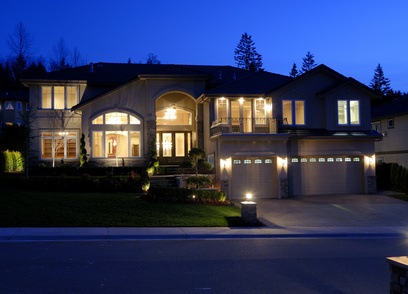 |
| Proper light placement provides safety and enhances your homes beauty. |
Adding exterior lighting to your home can be expensive so you want to get it right the first time. The main priority of exterior lighting is to provide safety at your home’s entrances and around vulnerable areas, but lighting should also enhance the beauty of your home’s exterior and surrounding property. To accomplish both these tasks it takes proper light placement.
Entrances
Lighting at the front door provides safety as you and guests enter the home, and it allows you to identify visitors before inviting them in. An adequate front light should also illuminate the lock for easy entrance. Some homeowners assume that a front light needs to be big and bright, but that’s not necessarily the case. If the scale of your home is grand a large fixture is the right choice, but for the average-sized family home multiple lights are a better solution than one giant shining beacon. Consider placing identical fixtures on each side of the entrance or a pendant over the entrance and a decorative light on a nearby post.
Back and side entrances don’t require as much illumination as the front door, but you do still want them to be well-lit. Motion-sensitive lights are a good option for rarely used entrances.
Walkways
Lighting is a must where ever there are steps, slopes or grade changes. Make certain ground lights are well out of walking paths and that pendants are placed low enough to illuminate without hitting anyone’s head. Post lights are traditionally used to signal a home’s driveway entrance, but if you have a long driveway additional lights will look impressive while guiding visitors to the front of your home.
Shrubs and plantings can create vulnerable areas around the home and allow prowlers to access first-floor windows. Up lights tucked into the landscape and aimed toward the house increase safety and cast dramatic shadows that give your home visual interest at night.
 |
| Ground lights should be well out of walking paths. |
Outbuildings
The exterior of the garage and other outbuildings is often overlooked when it comes to lighting. A motion-detecting light that illuminates only when a car or person approaches provides safety without leaving a light on constantly.
Decks and Patios
A deck with steps but no lighting is an accident waiting to happen. In addition to entryway lights, illuminate steps with built-in lights or rope lighting that outlines the edge of each riser. If you plan on grilling after dark, include task lighting in your work area.
Other Considerations:
- Some states, counties and HOAs have ordinances that require home owners to use Dark Sky or energy efficient certified lights. Make certain you know the requirements before investing in fixtures.
- Inside you may want bright, white lights, but outdoors a soft, warm light is more appealing. Stay within the 40 to 75-watt range when using single incandescent or 9 to 13 watts when using fluorescent.
- Look for lights that are listed Damp Location or Wet Location for places where the lights won’t be covered, such as a driveway post. If you live near an ocean or lake consider using exterior fixtures made from marine-grade resin for the best durability.
The style of your exterior lights should complement the style of your house. While it’s not necessary for all the fixtures to “match”, in most cases it is best to use one tone of metal for all of the lights. With a single color to unite them, pendants, torches, wall lights and landscape lights will look harmonious day and night, like the perfect touch of jewelry adorning the outside of your home.
For videos & tips on exterior lighting and other home related items, please visit: www.homechanneltv.com.
